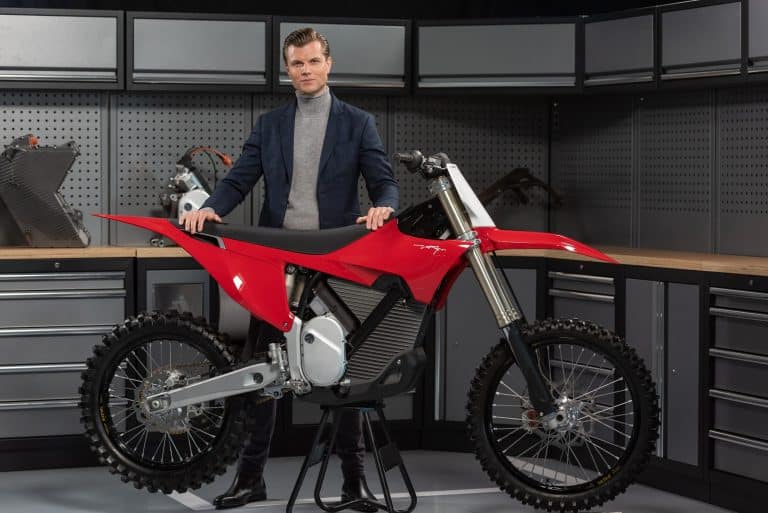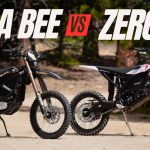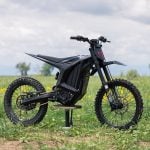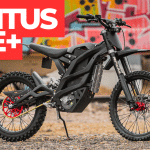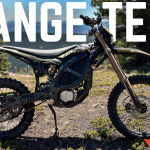Anton Wass began his career as one of the founders of 24MX, Europe’s largest motocross and enduro store. Now, as the founder and CEO of Stark Future, he has his eyes set on a new goal: to make the best electric motocross bike on the planet. We sat down with Anton to learn a bit more about himself, the Stark Future company and their new bike, the Stark Varg, which has created a lot of attention in the motocross community.
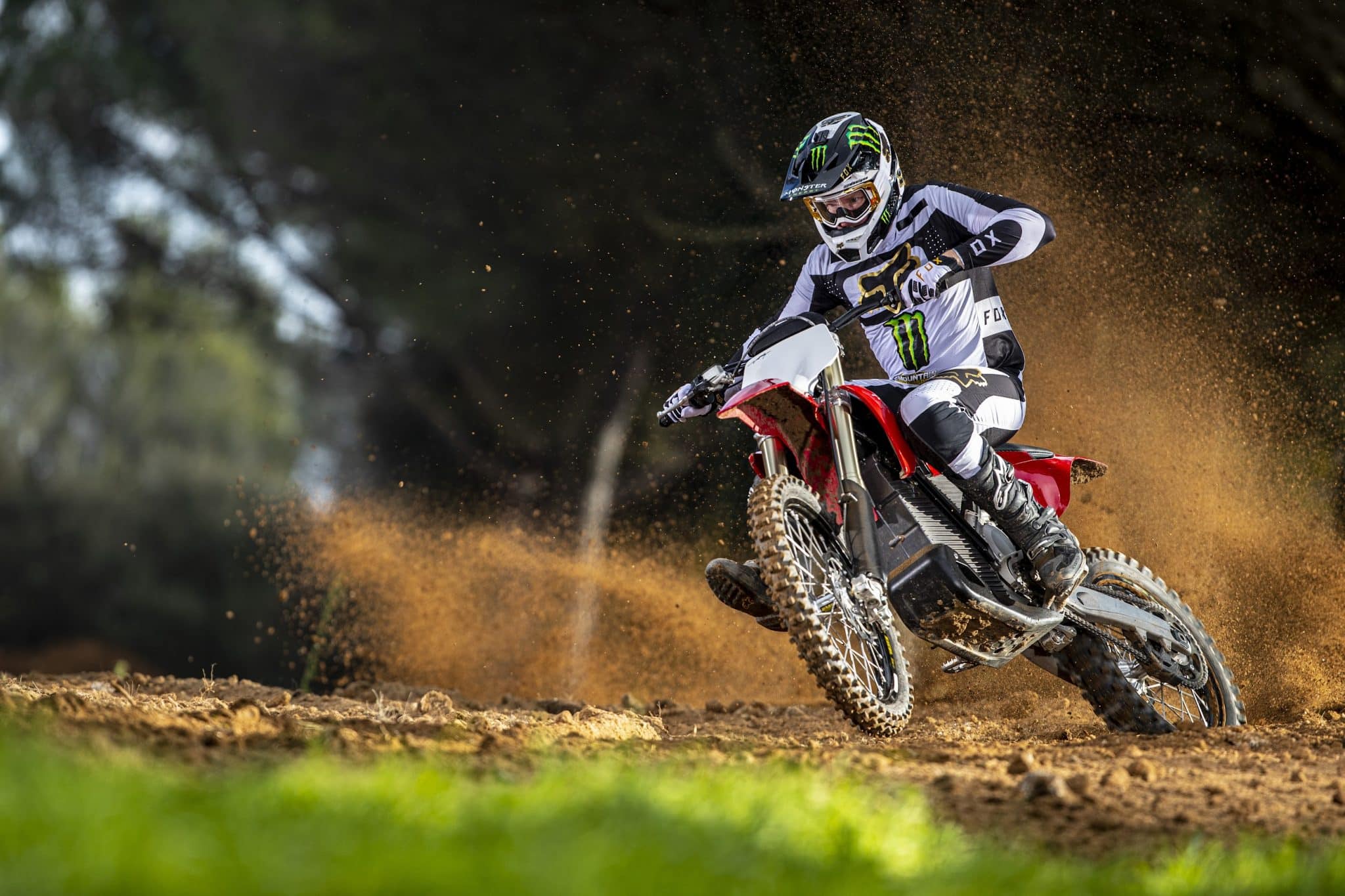
Tell me, what made you dream up this idea to come up with an electric motocross bike?
I’ve been thinking about it for such a long time. You know, what could be done? The most motivating factor is to build electric bikes that are better than the best gas bikes of today. I always thought it should be possible. In our initial analyze, we came to the conclusion that it is. And I think if you can build electric bikes, electric motorcycles, that outperform gas, it’s just better in every single aspect. There is no noise. It’s so much easier to ride. Less maintenance. If you think about the world today, I think sustainability is incredibly important to build a planet that, you know, is also good tomorrow, but you don’t want a boring future. You want a more fun future and that’s what we’re trying to create. Motivate people to go sustainable basically by building a better product and, yeah, that’s a lot of fun.
You’ve put together an amazing team over there at Stark. From your engineers to your test riders and everybody in between. How has that really shaped this company?
I built another company before where we had 400 employees and you can really see the difference, you know, a team of super high performers versus a team of average and the difference is incredible, especially when you’re trying to do something that’s cutting edge. And that’s why we’ve had a really strong focus, building a team of the best people within each area, engineering, design, sourcing, supply chain, communication, production, and yeah, I think that’s why we’ve been able to move so fast.
Moving fast is a great point, I don’t think a lot of people know the background of when this all started for you. I was surprised to learn that you guys have got a lot done in a short amount of time. When did this all start?
Two and a half years ago.
That is pretty unbelievable to develop a bike like this in that amount of time.
Yeah, it is pretty unbelievable. This bike is faster than any of the other gas bikes and there are companies that have been building motorcycles for a hundred years. In two years, we’ve been able to build a bike that outperformed that with a different technology, which is so, so motivating. And I think it’s really only possible because we had the right team behind us.
What is your reaction to all the attention that Stark Varg has gotten? When I found out about it, I was excited, but this is the world that I live in. Were you surprised with the overwhelming reaction to the release of the bike?
Yeah. I mean, obviously when you’ve been thinking about it every single minute for years, and you have this idea that you think this is something people would really get motivated appreciate it. And finally, after years to unveil it to the world and see that, wow, the reaction is even greater than what we thought. That is such an incredible feeling. The confirmation that what everyone has been doing and all the hard work has been, has been done in the right direction. So that question is now out of the way. Now we have to hurry up and build and deliver some bikes. We had high expectations, but the direction from the motocross world has been just incredible and so much more than we expected.
How are you meeting that demand? I know that you mentioned you’ll be potentially expanding production as a result. Obviously it exceeded your expectations. So how do you react to that?
We had prepared two factories to be able to build both the batteries and bikes, but the planned initial capacity was 5,000 bikes for the first year. And this is not even close to the volumes that people are demanding from us right now. So we have signed a new factory that will give us the capacity of up to 150,000 bikes per year and we’re preparing that factory right now. So we will be moving in there in less than a month and will get the production lines up and running there. So, it’s an incredible project that’s being run by our production team. But so far they’re keeping the time plans in terms of the lines. We have some delays in supply chain so we will be a little bit late with the first bikes, but not too bad. It’s just an extreme focus right now. The whole team, everyone is working 12 to 15 hours every single day. So it’s very tough, but still, you know, everyone is quite pumped. So it’s really fun. We are in the middle of the race right now.
Is all the production happening in Spain?
Yeah. So we’re building both the battery, which is mostly an automated line, so mostly robots, building the battery, and then the assembly of the bike is a more standardized assembly line with electronic torque wrenches and several stations assembling various parts. All of that is done here outside Barcelona.
Now demand wise, where are you seeing a lot of these orders coming from? Is there a trend or is it pretty spread? Do you see a focused group that is interested in the bike?
I think we had a pretty good idea where the motocross market is located geographically across the world before we started. Looking at the numbers, now in terms of the split per country, it’s pretty much what we expected. More than half of the sales are in US. That’s the world’s biggest market, so it’s not so unexpected. Then, of course, Australia, New Zealand, France, United Kingdom are also big markets. Sweden is surprisingly big also. It’s not the biggest market in the world, but it’s a lot of Swedes that want to ride electric bikes apparently.
I know that you’re from Sweden originally, but it just seems like there is a strong pull for electric in Sweden and for such a small country, I feel like they’ve made such big strides in that direction. Do you have any insight into that? Are there incentives? Is it just culture?
I think it’s mostly culture although there are some incentives in terms of cars. So if you look at the Nordics today, I think more than half the new cars sold are electric. In Norway, there are some very strong financial incentives that are pushing electric extremely hard forward, but in Sweden, I don’t think we have any real big incentives. I think it’s just a strive for the future. People care about sustainability people also very interested in the latest technology, not only in vehicles, but in general, and yeah, people want to try the latest stuff.
After going into the YouTube comments in our videos on the Stark Varg, it’s a roller coaster of reactions. As expected, there are skeptics out there regarding the power and the weight and the range of the bike. What do you have to say to those skeptics that are out there?
It depends a bit what the question is, but, you know, can we reach the power? That might be one question and right now. Yes, we can. It’s more power than you need, [laughs] but we can reach it. If you look at electric technology today, the numbers that we are reaching is absolutely possible. It’s nothing strange. We are considering a six kilowatt battery is delivering roughly 60 kilowatts of peak power. that’s, that’s quite normal.
In terms of range, it really depends on your riding. What we have said is that the bike can complete a full heat at an MX GP level. So, you know, a very fast rider going full speed at track. Then you can see trail riding for six hours, which is a massive span of course in time, but it’s really, it’s a huge difference in how much energy you use and what you can see when you put an amateur on a motocross track going full speed. You get one to one and a half hour range, because you simply can’t use more energy unless you have the skills. So, you know, there are a lot of people doing calculations that perhaps don’t see all the facts. If you actually just look at the energy density of fuel of gas versus energy density of batteries, the difference is incredible. But, you also need to look at the efficiency of the powertrain.
I mean, the efficiency of a motocross motor is maybe 15%. Yeah. So you basically lose all the energy, even if the energy density in the fuel is incredibly high. And then if you look at an electric powertrain, you can have an extremely high energy efficiency. So, that’s important to take into consideration. If you calculate the whole flow, basically from the energy source out to the wheel, then you can see that it’s completely realistic. Then you can also compare it to other electric vehicles. I mean, the Tesla model three is one of the best selling cars today. It has a 75 kilowatt battery. It’s a two and a half ton car. It weighs like five, 6,000 pounds. And our bike is, you know, 5% of that weight or less, but the batteries almost a 10th of the volume. So that also gives some perspective of the range. So I think, people don’t really know exactly how to calculate it, but soon they can try it and they will see for themselves, that’s always the best, best way.
Can you get into that battery design a little bit? I’m sure you won’t tell us all the engineering on it, but maybe zoomed out perspective. What type of cells are using? How is the honeycomb casing working to keep the battery cooled and efficient and provide all the power that you need for the bike
So the structure is pretty simple. There are basically three patents inside the battery. One is the honeycomb structure, which is the inside of the case, which has a honeycomb structure as the name says, where each cell is mounted directly into the case. So that’s creating a direct heat path from each cylinder cell. We’re using 21700 format, so that each cell has a direct cooling path to the case, which is then air cooled. It is an extremely efficient set up, which is removing a lot of parts, a lot of weight, and obviously a lot of volume also. Air cooling is allowing us to not have to use water cooling or any other kind of complicated and heavy system that would compromise the bike. So that’s a very, very important feature. Of course, we need to use a specific type of cell also.
So we need to use a cell with very high efficiency and very low internal resistance so that we don’t generate too much heat. But with this setup, we are not able to overheat the battery. And then we have another patent, which is just basically the inside cell holder, which has a part we call slippery fingers [laughs]. It’s difficult to explain that. How do you align 200 cells into 200 holes at the same time? It’s basically impossible. It’s not the most sophisticated patent. It’s basically 200 triangle shaped fingers that puts all the cells into place, which is basically technology only used for producing the battery. Without that, you have this great idea if you could build it, but if you can’t produce it then you can’t use it.
So that’s the whole function of the slippery fingers. And then we have a patented valve system that me and Paul developed together, which is not allowing any moisture to come inside the battery. If you look at a lot of electric motorcycles today, they use a kind of go around. It’s kind of a Gore-Tex membrane to allow air and pressure to go in and out of the battery, because with temperature and altitude changing, the pressure inside the battery also changes and you can’t have over pressure. Well, I mean, depending on how you build it, but it’s normally not a good idea to have over pressure. And by having a Gore-Tex membrane, you also allow moisture to go through. I mean, if you think about the Gore-Tex jacket, that’s exactly the same thing. It does rain doesn’t come through, but your sweat can go out. So that creates a risk for condensation. So we developed this valve, which is not allowing any moisture to come inside basically.
So does that design allow the bike to essentially be waterproof or water resistant? Asking for the guys that are going to try to take this thing through a river or water crossing.
I think we all have probably dropped our bike in a river! [laughs] I did that in Costa Rica in the middle of the jungle, [laughs]. Yeah. That was a tough situation. Fortunately, we got the bike started after half an hour or something like that. Now this bike, you can drop in a river. You know, it depends on how deep it is of course, but a normal crossing. It won’t be a problem. It’s IP 69 K, which means that it’s a pressure washer safe. So the entire bike is IP 69 K, which is basically the highest level if you don’t look at Marine equipment going down deep, which is very important for us, you know, having electronics on the bike, we don’t want to take any risk of what can get inside. Even the simple switches on the handlebar and stuff like that. We still want to make sure that you won’t have any kind of issues.
Obviously the battery is a huge innovation on your end, but what else are you most proud of on the bike? You have some groundbreaking developments that you’ve implemented into the bike. Walk me through some of the things that you’re most proud of on a bike.
Of course the electronics, the electronics team that we have in Croatia they’re are incredibly talented. They have developed a power density in the inverter and the motor that is the best that we know of, of any vehicle. So they’re incredibly skilled at what they’re doing. So that’s of course, I don’t know if I can say that I’m proud of their achievement, but I’m very glad to have them on the team and be working with them. They’re really talented guys and gals. And I mean, also the construction of the whole bike is something that I feel very proud of that we have integrated everything so well, we haven’t just taken a chassis and tried to put a motor in a battery inside it because that that really be able to compromise. But we developed everything together as one package to work perfectly together. And I think we have created a construction that is very optimized for its purpose and that’s something I’m really proud of. And, and it also aligns well with engineering and the design. So it’s not just, you know, an engineering package with a design over it, but it aligns quite well, which is something that’s important for us as well too, to have let’s say an honest design language on the bike.
Yeah. I mean, there are so many different areas of it. This is the lightest frame on the market. It’s the lightest swing arm on the market. It’s a very optimized triple clamp, very optimized wheels. We have some other new stuff will be coming shortly. That is also quite interesting on the bike, which I can’t tell you anything about today, but it might be a little bit lighter than what we said and you know, also the attention to detail. Yeah. So we will be releasing one use quite shortly in regards of the charger and the stand of the bike. So this is, this will come out in a few days and it’s just, you know, the attention to detail from everyone in the team to really deliver a product, which, you know, we can be proud of everything. There’s, there’s no compromise on it. Well, I mean, everything is a compromise, [laughs] but we’re very proud of all of it.
You know? And that is something that I think is really important. We had one detail that we, we developed a brake line holder and it was finished very early on. You know, it’s nothing important, it’s a brake line holder on the swing arm, holding the rear brake line. And it’s a very simple component of course, but we did it in plastic because that’s what everyone does. And the company mission is to reduce plastic and CO2 pollution. So we used plastic, even though we didn’t have to, and it was also quite bulky and not really beautiful, maybe even ugly. We weren’t happy about it. Now, a couple of our designers and engineers just spent a few days and built a super, super nice brake line holder in aluminum and so forth. I mean, for me, I’m really happy about knowing that we get all of those details right. That’s might be a bit nerdy but, I really think it matters a lot.
I had some questions from our audience about the smartphone display. Will the bike run if that is not connected to the bike? Does it need to be in the handlebars to have the bike operate?
No, you can lock the bike and remove it so that you can use it as a key. If for some reason you would like to do that, but if you don’t lock it, you can remove it and continue riding, the only difference is you won’t see the information that’s on there. And the reason we did that is, you know, if someone is deep inside a forest or jungle or whatever, and they crashed the bike falls upside down and hits a very sharp rock that would smash the display, which could happen. We don’t want them to be stranded. So the bike will run without the display. You can also remove it, if you want to.
Will the bike charge the display when it’s connected to the bike or does it have to be fully charged when you plug it in?
The bike is charging it wirelessly.
So let’s get back to charging a little bit, you know, we were just talking about that and I’m curious what the anticipated charge time is. Obviously in Europe, you guys use 220 to charge. Here in the US we have that, but it’s more normally 110. What should we expect for charge times currently on the bike?
So with the standard charger that’s included with the bike, 220 volt 16 amp, which is what’s standard in Europe. You have two hours charge time. In the US the charger will come with the plug for 220 volts because that will give you faster charging. Then you can use a normal converter and use 110 outlet, but then the charging time might increase depending on how many amps you have in that outlet.
You see these Tesla chargers popping up all over the place. Do you have any thoughts for future charging at tracks or riding areas that are Stark specific? Or how do you envision that? I’m sure you’ve thought about it.
Yeah. I mean, it’s all about making it as convenient as possible for the customer and one way of doing that is of course having superchargers. So what we’re doing is we’re talking to the tracks where we have the most amount of customers and we have contacted those tracks. So we would run a pilot project first to install a certain amount of Stark superchargers at motocross tracks. You can rapid charge your bike there. We still think that for most people, one charge will be enough for a day, but lets say you have a race and you have training, okay. Then you will need to charge the bike. And our idea is to implement and install this at motocross tracks all over the world, but we will start with a few tracks just to see how it works.
So when will we see a Stark Varg at a motocross or Supercross event?
Well, we have actually confirmed two races. Sebastian Toretelli will be going to the vet world champion championship race in the UK. I believe that’s in September. Then we also have one race in Italy happening after summer. I don’t know if that’s September or close to September. So those two are confirmed and then we have some others that are in discussion. So yeah, we want to go race. Let’s see when and where.
What is next for Stark Future? Is there a dual sport on the horizon? Are there other bikes that you’re considering? I don’t want to get away from the Varg because that is the most exciting topic, but what’s the plan moving forward? Do you have other models that you want to come out with?
So the Varg will come out also as an enduro and supermoto model. We will have to see exactly when, from a timing perspective, but we’re working on that. We will also release motorcycles in all of the major categories. We have started developing those projects right now.
I think it would be quite exciting. I mean, the whole purpose is we believe that every bike we will release will be the, the category leader in terms of performance and overall functionality. So it’s a massive project. It’s an extreme challenge of course, but it looks like we can release something that’s quite interesting, but time will tell.

